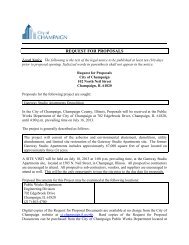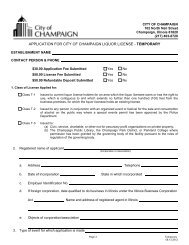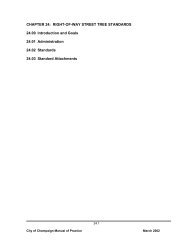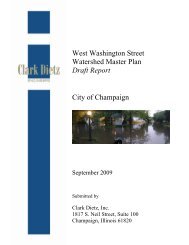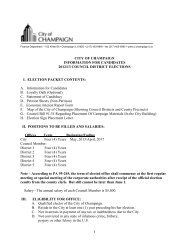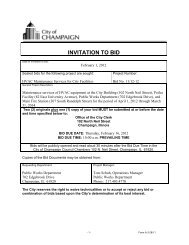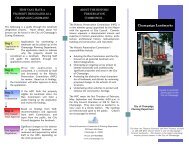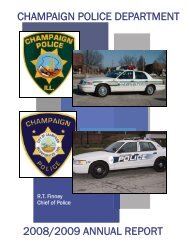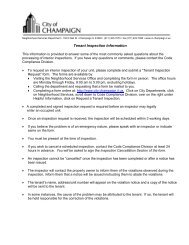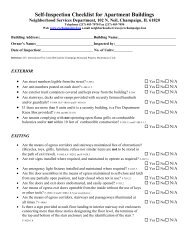2010-2014 Consolidated Plan - City of Champaign
2010-2014 Consolidated Plan - City of Champaign
2010-2014 Consolidated Plan - City of Champaign
Create successful ePaper yourself
Turn your PDF publications into a flip-book with our unique Google optimized e-Paper software.
impacts the housing market in terms <strong>of</strong> tenure. Only 47% <strong>of</strong> the <strong>City</strong>’s occupied housing units wereowner-occupied in 2000. When the University District (<strong>Plan</strong>ning Area 3) is excluded from the housingequation, the owner-occupancy rate rises to 59%. Approximately 51% <strong>of</strong> the <strong>City</strong>’s housing units werebuilt before 1970 and most <strong>of</strong> the oldest housing stock in the <strong>City</strong> is located within the lowest incomeCensus Tracts.Data collected through the Neighborhood Wellness <strong>Plan</strong> update process provided critical informationabout the value and condition <strong>of</strong> the housing stock across the <strong>City</strong>. In several planning areas, 1, 2, 4, 6,7, 8, 9 and 14, property values were found to be below the citywide median. Properties tended to ratelower on the condition survey in these planning areas than in other parts <strong>of</strong> the <strong>City</strong> as signs <strong>of</strong> age beginto show. Many <strong>of</strong> these areas also have median incomes below the <strong>City</strong>’s average. Public investment inthese neighborhoods will be necessary to enable lower-income homeowners to maintain property valuesand to encourage the continued investment <strong>of</strong> private resources.A full analysis <strong>of</strong> the <strong>Champaign</strong> housing market is available in the five-year <strong>Consolidated</strong> <strong>Plan</strong>.GEOGRAPHIC DISTRIBUTION AND TARGETED AREASWith the release <strong>of</strong> low/moderate (low/mod) income block group data from the 2000 U.S. Census, the<strong>City</strong> redrafted its target neighborhood map. Low/mod areas are defined as areas in which more than50% <strong>of</strong> the residents have annual incomes at or below 80% <strong>of</strong> the area median. The low/modneighborhoods as determined by the 2000 Census are depicted in Exhibit 1. Any federally-fundedactivities designated to benefit a low/mod area (LMA) will take place within the area shaded in red.The low/mod areas closely coincide with neighborhoods designated as Restoration and Preservation areasin the Neighborhood Wellness <strong>Plan</strong>. Several planning areas that were classified as Preservation areas in1992 have now improved to Conservation in the 2003 plan update. However, <strong>Plan</strong>ning Areas 1, 2, and 8are still low/mod in their entirety, while the majority <strong>of</strong> households residing in areas 3, 4, 7, and 9 werealso considered low/mod in the 2000 Census.The supply/demand, age/condition, and cost <strong>of</strong> the <strong>City</strong>’s housing stock were all analyzed as part <strong>of</strong> theNeighborhood Wellness <strong>Plan</strong> update process. The information for the analysis report was collected by<strong>Plan</strong>ning Area. The <strong>City</strong> uses these geographic areas as the basis for collecting neighborhood informationand allocating services. Exhibit 1shows the <strong>City</strong>’s low/moderateneighborhoods (HUD-definedtarget areas) overlayed on theNeighborhood Wellness <strong>Plan</strong>ningAreas. As noted on the map, all<strong>of</strong> <strong>Plan</strong>ning Areas 1, 2, and 8,most <strong>of</strong> Area 4, and almost theentire residential section <strong>of</strong><strong>Plan</strong>ning Area 7 are consideredlow- and moderate-incomeneighborhoods, by HUD’sdefinition. This means that morethan half <strong>of</strong> the residents inthese areas have incomes thatare below 80% <strong>of</strong> the areamedian income. Also, <strong>Plan</strong>ningArea 14, although notlow/moderate income by HUD’sdefinition, has a median incomethat is less than the <strong>City</strong>’sMattis104 FY <strong>2010</strong>/11 Annual Action <strong>Plan</strong>: Geographic Distribution and Housing Market Analysis



